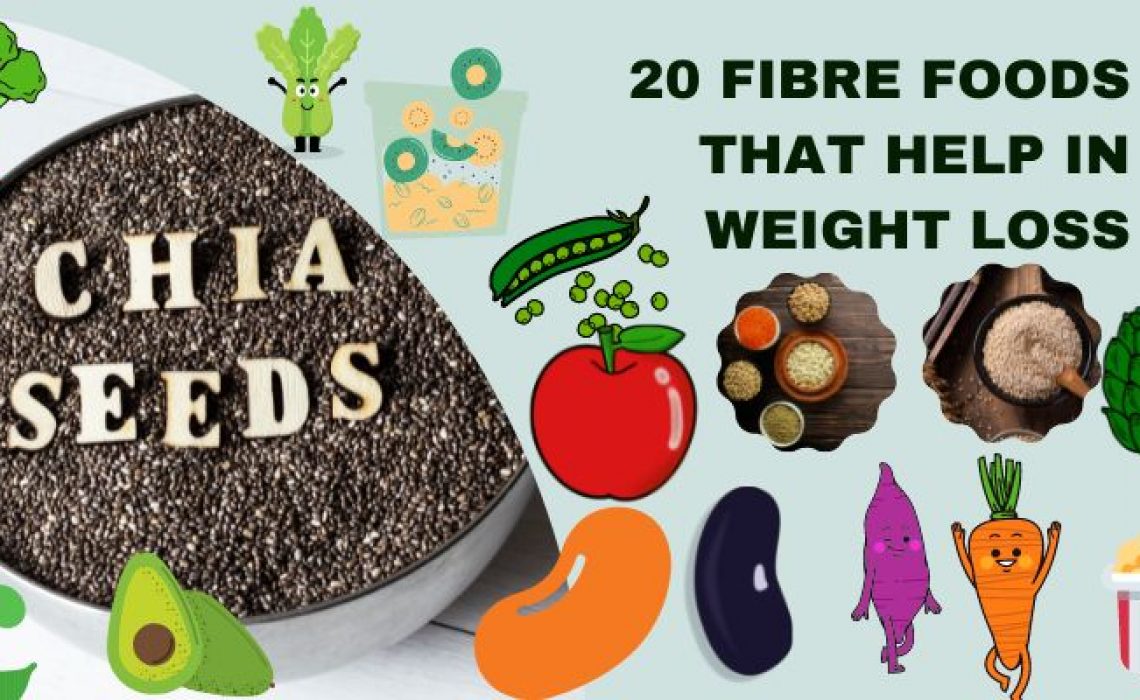Fibre foods for weight loss, it’s better to get a little clarification about how fibre foods help in weight loss, which fibre is better for weight loss, soluble or insoluble, how much fibre we need daily to promote weight loss, and how to start the routine so that the body gets used to it without any side effects. A clear understanding of concepts is helpful in achieving our goal. Just keep in mind that plant foods are the only sources from which we get fibre. Meat and dairy don’t provide fibre. And fibres present in processed foods are largely broken down or destroyed, making them a bad choice for weight loss.
Table of Contents
ToggleWhich fibre is better for weight loss-soluble or insoluble?
Fibres are carbohydrates that are not digested by the gut.
There are two types:
- Soluble
- insoluble
Soluble fibre dissolves in water and insoluble doesn’t. Soluble fibre is recommended for weight loss. Let’s now understand the function of soluble fibre in weight loss.
How does soluble fibre help in weight loss?
There are trillions of friendly bacteria present in the gut, particularly in the large intestinal flora known as gut fibre or gut microbiome. The gut microbiome is essential for maintaining overall health and managing weight.
The fibre These microbiomes eat soluble fibres, which make it through the digestive system without getting broken. Bacteria digest fibres and convert them into usable energy.
These fibres are also known as prebiotic fibres or fermentable fibres. They are highly beneficial for losing weight.
Another important function of fibres in weight loss is that they make us feel full, which reduces our appetite and food intake, which automatically leads to weight loss.
Now, as we understand the basic function of fibre in weight loss, let’s get to know the quantity that we need to consume.
How much fibre to promote weight loss?
The fibres are present exclusively in plant foods. And as we all know, whole food is better than supplements, so try to intake fibre-rich whole foods instead of fibre supplements to get the full benefit of fibre in weight loss.
To start your high-fibre diet for weight loss, remember to go slowly so that your body can gradually adjust to the new routine.
Otherwise, you can suffer from common side effects such as abdominal discomfort, cramps, or even diarrhoea if you go too quickly.
Now, we will discuss the 20 high-fibre foods that aid in weight loss.
Here are 20 fibre-rich foods that help with weight loss. We are going to discuss foods that are high in fibre, and we have a long list of varieties of fibre foods so that we can change them often according to our likes and moods or availability.
We get these fibres from different groups of plant foods, such as vegetables, fruits, legumes, whole grains, and nuts.
Vegetables

1. Broccoli (3 g fibre per cup)
It is a type of cruciferous vegetable and one of the most nutrient-dense foods known.
It provides a good amount of dietary fibre, roughly 3 grams per cup, or 2.6-grams per 3.5 ounces (100 grams). More than half the fibres present in broccoli are soluble in nature.
- Other benefits: Besides being beneficial for our gut health and weight loss, it is also rich in vitamin k, vitamin c, vitamin B, folate, potassium, manganese, and iron. It also contains antioxidants and has anticancer properties.
2. Carrots
1 cup of carrots (128 grams) – 4.6 grams of fibre 2.4 grams of fibre are soluble.
- Other benefits: High in vitamin K, Vitamin B6, magnesium and Beta carotene (antioxidant). Beta carotene turns into vitamin A in our body.
- Carrots can be used to make a variety of dishes, sweet and salty, so they can be easily included in the diet. It is eaten raw as well.
3. Artichoke
1 raw globe or French artichoke, 6.69 grams of fibre.
or 100 grams of artichoke—5–4 grams of fibres.
It is one of the world’s best sources of fibre.
- Other benefits: rich in antioxidants, folate, vitamin C, vitamin K, magnesium, phosphorus, potassium, and iron. Also low in fat.
- It has an unsettling taste, but as previously stated, there are numerous reasons to use them. It can be used steamed, roasted in salads, pizzas, or scrambled eggs.
4. Brussels sprouts
1 cup (156 grams) of Brussels sprouts-4 grams of fibre
100 grams of Brussels sprouts – 3.7 grams of fibres.
- Other benefits: very high in vitamin K, potassium, folate, and potent cancer-fighting antioxidants.
- They can be eaten roasted with apples and bacon or drizzled with balsamic vinegar.
5. Spinach
1 cup (cooked) of spinach – 4grams of fibres
It is full of fibres.
- Other Benefits: rich in vitamin A, Vitamin C, vitamin K, iron, folate, potassium and oxalate.
6. Sweet potato
1 medium sweet potato – 3.8 grams of fibre
100 grams of sweet potato – 2.5 grams of fibre
- Other benefits: high in potassium, beta carotene, vitamin B, and vitamin A.
Fruits

7. Apple
1 medium raw apple – 4.4 grams of fibre
100 grams of apple – 2.4 grams of fibres
- Other benefits: High in vitamin C, low in sodium, fat and cholesterol.
8. Raspberries
1 cup of raw raspberries – 8 grams of fibre
100 grams of raspberries – 6.5 grams of fibre.
- Other benefits: Loaded with vitamin C, and manganese. Also, contain a high amount of potassium and omega-3 fatty acid.
9. Avocadoes
1 cup of raw avocadoes – 8 grams of fibre
100 grams of avocadoes – 6.5 grams of fibre.
- Other benefits: High in vitamin C, potassium, magnesium, vitamin E, and vitamin B. Also loaded with healthy fats instead of carbs.
10. Pears
1 medium of raw pears – 5.5 grams of fibre
100 grams of pears – 3 grams of fibre.
- Other benefits: high in omega-6 fatty acid. Good source of vitamin C, potassium, and various antioxidants.
Legumes

11. Black beans
One cup of black beans – 15 grams of fibre
- Other benefits: Rich in protein and iron, low in calories is almost fat-free.
12. Kidney Beans
One cup of cooked beans – 12.2 grams of fibre
100 grams of cooked beans – 6.8 grams of fibre
- Other benefits: Loaded with plant-based protein and has nutrients and vitamin C. They also contain complex carbs and are almost fat-free.
13. Split peas
One cup of cooked split peas – 16.3 grams of fibre
100 grams of split peas – 8.3 grams of fibre
- Other benefits: Provides protein, manganese, phosphorus, magnesium, copper, iron, vitamin K, and vitamin B6
14. Edamame
One cup edamame – 8 grams of fibre
- Other benefits: High in protein, folate and vitamin K1, Also contains a good amount of iron, magnesium, phosphorus, potassium, copper, and calcium.
15. Lentils
One cup of cooked lentils – 13.1 grams of fibre
100 grams cup of lentils – 7.3 grams of fibre
- Other benefits: very high in protein and low in sodium and saturated fat. Also high in potassium, fibre, folate and antioxidants.
Whole grains

16. Oats
One cup of raw oats – 16.5 grams of fibre
100 grams cup of oats – 10.1 grams of fibre
- Other benefits: High percentage of quality protein, carbohydrates, beta-glucan, unsaturated fatty acid, minerals, vitamins and phytochemicals.
17. Popcorn.
1 cup of popped popcorn – 1-15 grams of fibre
100 grams cup of popped popcorn – 14.4 grams of fibre
- other benefits: contains lots of fibre antioxidants, proteins and carbohydrates. It also includes folate, niacin, riboflavin, vitamin B6, vitamin A, vitamin k, and vitamin E.
18. Flaxseeds
1 tablespoon of flaxseed – 0.6 to 1.2 grams of fibre
- Other Benefits: good sources of proteins omega -3 and antioxidants. Also have calcium, copper, magnesium, manganese, phosphorus and potassium. Also, low in calories.
19. Chia seeds
1 once-dried chia seed – 9.75 grams of fibre.
34.4 grammes of fibre are contained in a 100 grams cup of dried chia seeds.
It is considered the only best source of fibre on the earth.
- Other benefits: Contain a high amount of magnesium, phosphorus, calcium, proteins, and omega-3 fatty acids. Also contains zinc and copper.
20. Quinoa
1 cup of cooked quinoa – 5.2 grams of the fibre
100 grams of cooked quinoa – 2.8 grams of fibres.
- Other benefits: high in proteins, iron, vitamin B6, potassium, magnesium, zinc, and antioxidants. It is also gluten-free which makes it easy to digest.
Conclusion
The above discussion has made it easy to include fibres in our diets to promote weight loss. The list of fibre-containing foods that help in weight loss provides us with a variety of foods so that our diet plan doesn’t become boring. However, there are many more high-fibre foods that we can add.










2 thoughts on “20 Fibre foods that help in weight loss”
Pingback: 10 Facts About Falafel | Middle East Food - Easy Life
Pingback: 10 Things You Should Know About Quinoa|Benefits of Quinoa -